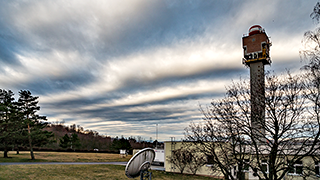
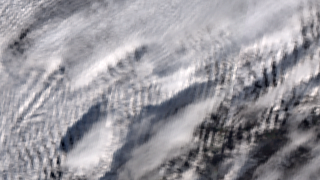
Ricoh GXR-A16, interval 5 seconds, speed 150x
20200217_0715-0842utc_Praha-Libus_1920x1080.mp4 (88 MB)
20200217_0715-0842utc_Praha-Libus_1920x1080_x265.mkv (115 MB, H.265)
Helmholtz cloud waves, Praha - Libuš. Waves in low clouds, which were formed by strong wind shear at levels around 2 km. Contrary to more frequent orographic waves, which form downwind of mountain ridges or islands and typically are quasi-steady or move very slowly, these wind shear-induced waves propagated very quickly in an eastward direction, even faster than the cloud base underneath. The wind shear can be nicely seen e.g. in this wind profiler plot from Temelín (south Bohemia, lower panel), and cloud height can be retrieved from the ceilometer plot from the same location (upper panel). The cloud height at the location from which the timelapse was taken (Praha-Libuš) can be seen in this ceilometer plot (no wind profiler there). In both plots, the vertical lines outline the period of the timelapse sequence. The sounding plots from Praha-Libuš from 06 UTC and 12 UTC show that at levels near 2 km there was no significant thermal inversion. Source of these plots: CHMI and EUMETNET e-Profile.
The appearance of these waves from above can be seen in satellite imagery at higher pixel resolution. In this Meteosat-10 (MSG-3) HRV band image (at resolution of about 1x2 km for this region) from the beginning of the timelapse sequence, the individual waves can be resolved. The red dot indicates the location of Praha-Libuš (from where the timelapse was taken), the green dot marks location of Temelín, and the sector outlines the horizontal range and direction of the timelapse. In this Meteosat-10 HRV loop (taken at 5 minute rapid scan mode) the sector also marks the timelapse interval. Despite the fact that the waves can be resolved in the HRV images, their motion can't be resolved in the loop due to their fast eastward propagation. Somewhat better resolution is available in this Metop-B AVHRR 1 km image, captured at the end of the timelapse series. However, the clearest image of these waves was recorded about 30 minutes later by the Sentinel-3B satellite with its OLCI instrument at 300 m resolution, shown here in the RGB composite image of bands 8, 6 and 4. From this image it is possible to retrieve the wavelength of these waves, which ranges from about 2 km near Praha (red dot), up to about 4 km in the other more distant regions. From the timelapse series it is possible to estimate the period of these waves, reaching about 85 seconds.
The timelapse series, unfortunately terminated by the memory card capacity, was captured from my office window at the CHMI Observatory Praha-Libuš, Czech Republic, with a southwestward view.

Samsung NX500 & Samyang 8mm F2.8 UMC Fisheye II, interval 30 seconds, speed 900x
20200422_1855-2015utc_Starlink_Okrouhlik_x264.mp4 (25 MB)
20200422_1855-2015utc_Starlink_Okrouhlik_x265.mkv (29 MB, H.265)
Starlink satellites on the evening sky above Prague. Captured from from Okrouhlík, central Bohemia, Czech Republic, northwest view.
More about Starlink project e.g. here.
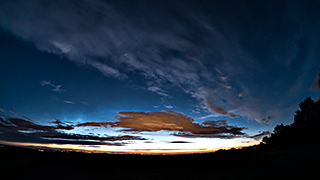
Samsung NX500 & Samyang 8mm F2.8 UMC Fisheye II, interval 5 seconds, speed 150x
20200606_1940-2055utc_NLC_Okrouhlik_x264_1920x1080.mp4 (68 MB)
20200606_1940-2055utc_NLC_Okrouhlik_x265_1920x1080.mkv (68 MB, H.265)
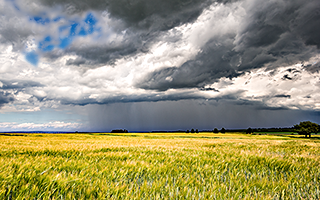
Samsung NX 500 & Samyang 12mm F2.0 NCS CS, interval 3 seconds, speed 90x
20200702_1127-1223utc_Mandava-Sulice_30-fps_x264_1920x1080.mp4 (65 MB)
20200702_1127-1223utc_Mandava-Sulice_30-fps_x265_1920x1080.mkv (70 MB, H.265)
Showers south of Prague. Captured from Mandava (south of Prague, central Bohemia, Czech Republic); first series northward view, towards Prague, second series westward view, at Sulice.
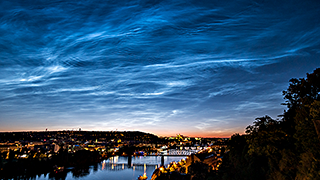
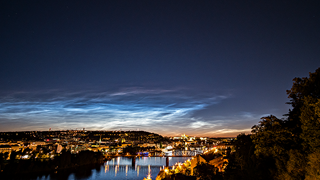
Samsung NX 500 & Samyang 12mm F2.0 NCS CS, interval 4 seconds, speed 120x
20200705_2000-2130utc_NLC_Praha-Vysehrad_x264_1920x1080.mp4 (123 MB)
20200705_2000-2130utc_NLC_Praha-Vysehrad_x265_1920x1080.mkv (128 MB, H.265)
On that day, the OSWIN radar was detecting increased activity of the Mesospheric Summer Echoes (MSE) since mid-afternoon till sunset (see this OSWIN radar record), indicating a very good chance for NLC show for that evening. As I noticed this relatively late, shortly after sunset, it was already too late to go by car somewhere south of Praha. Therefore, I decided for a backup plan - to go to Vyšehrad (the second main castle in Praha) and try observing and timelapsing the NLC from this viewpoint there. It turned out to be a great decision, as the composition of NLC above center of Praha is just spectacular. See also this larger photo (from the timelapse series), taken at about 20:20 UTC, at the time of most prominent appearance of the noctilucent clouds.
The gradual disappearance of NLC from upper to lower elevations in the images (approx. from south-east to north-west) - see the individual images from 20:20, 20:35, 20:50, 21:05 and 21:20 UTC - is caused by propagation of the Earth's shadow in the upper mesosphere, at heights of NLC occurrence (at about 80-85 km), during the "mesospheric sunset". You may also notice the pink tint of the upper edge of the NLC, caused by a similar mechanism as reddish color of highest tropospheric cirrus clouds after sunset. The timelapse movie is slightly over-enhanced, to show all the details of NLC and their dynamics.
To unambiguously exclude presence of high cirrus clouds (which in some cases, during early dusk, may slightly resemble NLC clouds), see this 20:35 UTC RGB-NM image (night microphysics RGB product) from Metop-B polar-orbiting satellite. Red lines indicate the sector covered by the timelapse. Within this sector, this image reveals low and mid-level clouds only, invisible from Prague, but no high cirrus clouds. In this image is also plotted location of the OSWIN radar, which is (due its azimuth and distance with respect to CZ) broadly used here as an early indicator of possible occurrence of evening NLC. Finally, the MSG RSS NM-RGB loop (18-24 UTC) shows evolution of the weather above Central Europe - we were quite lucky here, in Czechia...
-------------------
My older NLC cases can be found here:
2009-07-14, 2013-06-27, 2014-07-03, 2015-07-10, 2016-07-05, 2018-07-02/03 and 2019-06-21
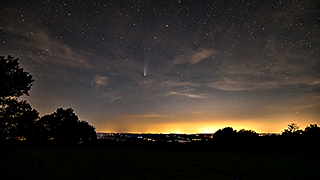
Samsung NX 500 & Samyang 12mm F2.0 NCS CS, interval 20 seconds, speed 500x
20200722_2005-2118utc_NEOWISE_Kaliste_x264_1920x1080.mp4 (27 MB)
20200722_2005-2118utc_NEOWISE_Kaliste_x265_1920x1080.mkv (31 MB, H.265)
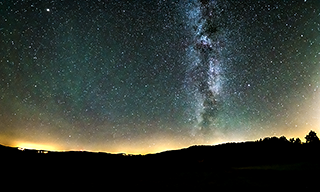
Samsung NX 500 & Samyang 8mm F2.8 UMC Fisheye II, interval 30 seconds, speed 900x
ISO 3200, exposure 25 seconds, F/2.8
20200820_1715_20200821-0555utc_Jankovska-Lhota_x264_1800x1080.mp4 (123 MB)
20200820_1715_20200821-0555utc_Jankovska-Lhota_x265_1800x1080.mkv (121 MB, H.265)
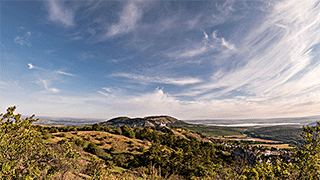
Samsung NX 500 & Samyang 8mm F2.8 UMC Fisheye II, interval 5 seconds, speed 300x
Original color version:+
20200920_0615-0800utc_Palava_60fps_1920x1080_rgb.mp4 (75 MB)
Enhanced greyscale version:
20200920_0615-0800utc_Palava_60fps_1920x1080_bw.mp4 (75 MB)
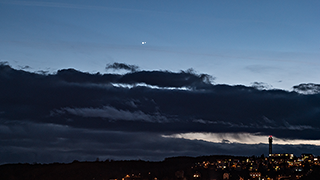
Samsung NX 500 & Asahi Takumar SMC 55mm F2, interval 3 seconds, speed 90x
20201222_1542-1612utc_Praha-Vysehrad_x264_1920x1080.mp4 (43 MB)
20201222_1542-1612utc_Praha-Vysehrad_x265_1920x1080.mkv (43 MB)
Jupiter and Saturn setting into clouds, one day after their very close conjunction. Captured from fortification walls of Vyšehrad, Prague, Czechia.